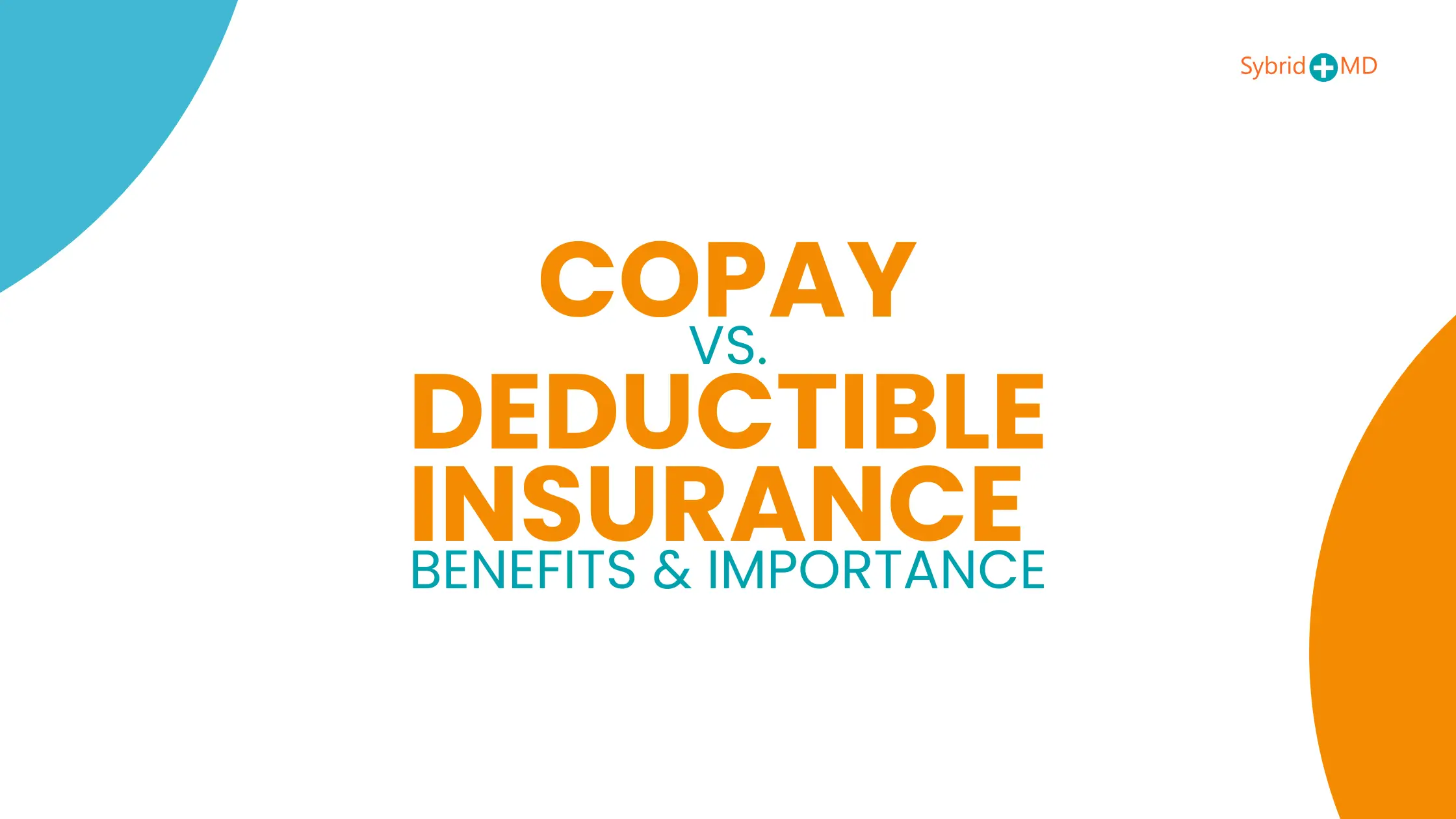When exploring the world of well-being insurance s, terms like “copay” and “deductible” frequently cause disarray. These concepts are basic to understanding how insurance costs are dispersed and what you might owe when looking for therapeutic care. In this article, we’ll break down the difference between copay vs. deductible insurance, providing clarity on these fundamental terms.
What is Copay?
A copay, a brief for copayment, or maybe a settled sum you pay for particular restorative administrations or medicine drugs. For illustration, you might have a $30 copay for a doctor’s visit or a $10 copay for a nonspecific medicine. Copays are ordinarily laid out in your insurance plan and shift based on the sort of benefit you receive.
Key Highlights of Copay
- Fixed: The sum is predetermined and does not change with the total cost of the service.
- Applies Per Visit: You pay a copay each time you get to certain services.
- Exclusions: A few administrations, particularly preventive care, may not require a copay.
- Examples of Copay
For example, you might pay a $30 copay each time you visit your primary care doctor, in any case, regardless of the overall cost of your insurance plan. Visits to specialists, such as dermatologists or cardiologists, may involve a copay, typically around $50.Medication solutions often come with different copay amounts: $10 for generic drugs, $30 for preferred brand-name drugs, and $50 for non-preferred brand-name drugs. Depending on your plan, urgent care visits may have a lower copay, such as $100 or more. These fixed payments help you anticipate out-of-pocket expenses for scheduled medical care. For better understanding, read this blog about Copay.
What is Deductible?
A deductible is a sum you must pay out of the stash for healthcare administrations. Sometime recently, your insurance s started to cover costs. For occasion, on the off chance that your deductible is $1,000, you may have to pay that sum for qualified administrations upfront before your insurance contributes.
Key Highlights of Deductible
1. Deductibles typically reset at the beginning of each calendar year.
2. High-deductible well-being plans (HDHPs) regularly include lower premiums but higher deductibles.
Example of Deductible
Imagine your insurance plan has a yearly deductible of $1,500. Early in the year, you need a restorative procedure that costs $3,000. Since you haven’t paid any part of your deductible yet, you’ll need to pay the first $1,500 out of pocket. After meeting your deductible, your insurance will cover a portion of the remaining $1,500 based on your policy’s terms. For example, if your plan has an 80/20 cost-sharing arrangement, you would pay 20%, and the insurance would cover 80%.
Any qualified restorative costs incurred within the same year will result in decreased out-of-pocket expenses since you have already met your deductible.
What is Copay with Deductible Meaning
Some well-being insurance plans include both copays and deductibles. This means you only pay a copay for certain services without having to meet your deductible first. For example, preventive care services may require a $20 copay that does not count toward the deductible, while other services may only be covered after you have met the deductible.
Is Deductible the Same as Copay?
No, deductibles and copays are unmistakable components of wellbeing insurance. A deductible is the whole sum you must pay out of take for secured healthcare administrations some time recently your insurance starts to share the costs. For example, if your deductible is $2,000, you’ll got to pay for all secured therapeutic costs up to this sum some time recently your insurance s takes impact. This is often common for administrations such as healing center stays, surgeries, or progressed demonstrative tests.
Once the deductible is met, you’ll still be mindful for copays or coinsurance. In differentiate, a copay could be a settled expense you pay for particular administrations, such as a $20 charge for a doctor’s visit or a $15 charge for a medicine. Not at all like deductibles, copays are regularly required at the time of benefit and may apply indeed in case you haven’t met your deductible for the year. For occasion, you might pay a $25 copay for a master arrangement, in any case of whether your deductible has been met.
Situation Examples for Copay and Deductible
Situation Including a Deductible:
In the event that you want services for an MRI costing $1,200 and your deductible is $1,000, you’ll pay $1,000 to begin with. After this, your insurance s will cover a portion of the remaining $200, depending on your plan’s coinsurance terms. For illustration, in the event that your coinsurance is 20%, you’ll pay 20% of the remaining $200 (i.e., $40), and the insurance s will cover the rest ($160).
Scenario Including a Copay:
In case you visit a primary care specialist and your arrangement indicates a $30 copay for such visits, you’ll pay $30 at the time of your arrangement, regardless of whether you’ve met your deductible.
Do You Pay Copay before Deductible?
This depends on your insurance plan. For a few facilities, you will pay a copay without pushing your deductible. For others, you ought to meet the deductible first before copays apply. Check your insurance plan points of interest regularly to get the available payments.
In many healthcare insurance plans, you are required to pay a copay before meeting your deductible. For example, if your insurance plan specifies a $30 copay for a primary care visit, you will need to pay this fixed amount regardless of whether you have met your annual deductible. This feature allows insured individuals to access essential healthcare services without the financial burden of having to meet the deductible first.
If you need to visit a specialist for a scheduled check-up, your insurance may require a $25 copay for such visits. You will pay this amount during your appointment. Even if your annual deductible is $1,000 and you have not yet contributed towards it, the only cost for that visit would be the $25 copay. This arrangement is particularly beneficial for those seeking routine or preventive care, as it ensures affordability and promotes early intervention.
However, not all administrations are subject to copays. For more complex restorative methods or hospitalizations, your deductible may come into play. In such cases, you must cover the total deductible sum before your insurance supplier pays or starts sharing costs. In such case, suppose you require an MRI costing $1,200 and have a $1,000 deductible, you’ll pay the primary $1,000 in total, in any case of any copay necessities. After deduction of the deductible, your insurance s may cover the remaining costs, frequently including extra copays or coinsurance.
This interaction between copays and deductibles shifts based on the particular terms of your insurer’s approach. Understanding these terms ensures you are prepared for out-of-pocket costs and can budget effectively for both scheduled and unexpected healthcare needs. By clearly defining when copays apply and when deductibles take precedence, you can better manage shared responsibility for healthcare expenses.
Is it better to have a higher copay or deductible?
Choosing between the next copay or deductible depends on your healthcare needs:
- Higher Copay: It is beneficial if you frequently access healthcare services, as it reduces upfront costs.
- Higher Deductible: Appropriate for those who often visit healthcare specialists and need lower month-to-month premiums.
What Does $30.00 Copay After Deductible Mean?
Understanding your health insurance can be exciting and empowering! Let’s break down how it works in a friendly way. If you have a deductible of $1,000, think of it as your initial investment in your health care. Until you reach that amount, which you’ve already started tracking, you’ll cover the full cost of services. So, if you’ve paid $500 so far, keep up the great work—you’re halfway to unlocking those benefits!
Once you meet your deductible, the fun begins! You’ll only be responsible for a $30 copay for specific services, like doctor visits or prescriptions. This flat fee makes managing your health expenses simple and predictable.
Remember, the $30 copay applies every time you use those covered services, allowing you to budget more effectively throughout the year. Just a little heads-up: your deductible will reset at the beginning of the next plan year, which means it’s a fresh start for your health journey!
Overall, this system is designed to help you share costs with your insurance provider, promoting a collaborative approach to health care. Embrace this opportunity to take charge of your health, and know that you have a partner in your insurance plan!
Do you pay copay before or after a visit?
Typically, copays are paid at the time of your visit. For situations when you check in for a doctor’s appointment, the front desk may ask you for your copay upfront. In any case, this may vary depending on the provider’s policies. The timing of the copay installment can vary depending on the healthcare supplier and the insurance plan. Normally, the copay is paid at the time of the visit. Once you go to a doctor’s office or drug store, you, as a rule, are required to pay the copay upfront to get the benefit. This payment is made at the time of the visit for restorative administrations, medicines, or other secured treatments.
However, a few insurance plans might permit for the copay to be charged afterward, particularly in case the supplier does not collect it at the time of the visit. It’s vital to check the particular terms of your insurance plan or contact your healthcare supplier to get all the information you need for copayments.
Is copay better than deductible?

1. Standard Healthcare Needs:
If you frequently visit healthcare providers for routine check-ups, medications, or specialist appointments, a plan with low copays can be very beneficial. These plans typically charge a fixed fee for each medical visit or service, which makes it easier to budget for healthcare expenses. For someone with ongoing medical needs, the cost per visit becomes more predictable and manageable, as copays remain the same regardless of how many times you see a provider.
2. Sporadic Healthcare Utilization:
If your healthcare needs are infrequent, a high-deductible plan with lower premiums may be more beneficial for you. These plans typically have lower monthly premiums but higher out-of-pocket costs when you need medical services. This option can be more cost-effective for someone who only requires healthcare services occasionally and is able to cover the deductible when necessary.
3. Balancing Costs:
The choice of a health insurance plan should be based on how often you expect to use healthcare services. If you are generally healthy and only require medical care a few times a year, a plan with a higher deductible and lower premiums might save you money in the long run, as your monthly premiums will be lower. On the other hand, if you anticipate needing regular access to healthcare services, a plan with lower copays might be more suitable, as it will reduce your out-of-pocket costs each time you seek care.
4. Overall Budget Contemplations:
The right choice also depends on your overall financial situation. If you have the budget flexibility to cover a higher deductible upfront, a plan with lower premiums may be the better option. However, if paying out-of-pocket for each medical visit would strain your finances, a plan with lower copays might be the more practical choice. The key is to find a balance between the cost of premiums, the amount of the deductible, and the copays for services you use regularly.
Final Thoughts
Understanding the difference between copays and deductibles is crucial for effectively managing your healthcare costs. By evaluating your healthcare needs and financial situation, you can choose an insurance plan that balances affordability with comprehensive coverage. Be sure to review your plan’s details thoroughly to avoid any surprises and make the most of your benefits.

